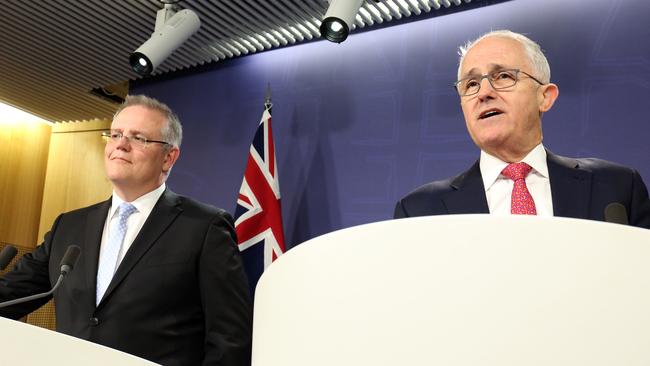How Hayne inquiry destroyed Turnbull’s economic policy

That’s the trouble with having only one economic policy — it’s like investing all your eggs in one basket. If it goes down, you’re toast.
And the company tax cut has turned into a failed investment for the Coalition because it has been destroyed by the banking royal commission. Of course, revelations about shonky behaviour by the banks and AMP have nothing to do with whether giving large companies a tax cut is good for jobs and growth or not, but such subtleties are irrelevant in politics.
And anyway, it’s a pretty thin excuse for an economic policy.
The Treasurer Scott Morrison did a big economic speech to CEDA about a month ago and, ploughing through 3,600 words, he talked about two things: personal income tax cuts and company tax cuts.
He built to a ringing crescendo.
“As a government we are achieving the goals of economic and social resilience by ensuring that we deliver on our plan for a stronger economy that I announced in this year’s budget:
* Tax relief to encourage and reward working Australians;
* Backing business to invest and create more jobs;
* Guaranteeing the essential services Australians rely on;
* Keeping Australians safe, and;
* Ensuring the government continues to live within its means.
“That’s our plan.”
The only one of those five items that had anything to do with a “stronger economy” was the second one — the company tax cuts. The others are all about a stronger vote at the next election.
Unfortunately, after Saturday, it looks like none of the five parts of the plan are working. Both the economy and the Coalition’s vote are weakening, not strengthening.
The banking royal commission has ensured that cutting the tax rate of large companies is not just a tough sell, as Christopher Pyne acknowledged on Sunday, but an impossible one.
Perhaps that’s what the government had in mind in opposing the royal commission for so long: the Prime Minister knew, or suspected, that it might blow up his economic policy.
Which is what has now happened — the Saturday by-election results merely confirmed it.
If the plan to cut the company tax rate from 30 to 25 per cent has to be dumped, as seems very likely now, the government will be left with no economic plan at all, or at least not one it will want to talk about.
In fact the true economic policy of the Coalition for more than 15 years has been population growth, or to be precise, immigration, and still is. It’s just that no one talks about it.
Net migration into Australia used to average about 80,000 a year during the 70s, 80s and 90s. After 2005 it was reset to 240,000. Births also kicked up from 120,000 a year to 150-160,000.
It was the most significant economic policy change since the floating of the dollar, possibly much earlier, and like all really important economic reforms, the effect of it keeps building.
The groundwork for this “reform” was laid in 2001 with the Tampa incident, when John Howard dramatically stopped 433 Hazara refugees from Afghanistan from coming ashore off the Norwegian ship, the HV Tampa, which had picked them up.
That was followed quickly by the introduction of the Pacific Solution and offshore processing of refugees to get them away from the Australian judicial system, which was being used to great effect by pro bono lawyers acting for refugees. It was followed quickly by the baby bonus in the federal budget of 2002, and that was subsequently increased from $3000 to $12,000 in 2004, when it really started to have an effect.
Of course, stopping the boats was an end in itself (there were 5516 arrivals in 2001), but as John Howard and others later explained, controlling the borders was a prerequisite for getting the Australian public to accept a much higher level of immigration.
The Coalition wanted to grow population more quickly to accelerate economic growth and to create a labour surplus that would help crush the unions, supporting the plan to introduce WorkChoices legislation and finish them off. The legislation proved to be a bust but immigration did the job … on the unions and on the economy.
Growth has continued to expand, helped by Chinese commodity demand, propelling Australia to a world record duration without recession, although per capita growth is a different story. There have been a couple of per capita recessions.
Several consequences have flowed from the Coalition’s use of immigration as economic policy.
Wages growth has stayed down, as intended to help business profit growth, but with the less intended consequence of low inflation and thus low interest rates.
Record low interest rates, indirectly caused by population growth, combined with 200-250,000 arrivals per year looking for somewhere to live, led to a 70 per cent increase in the median Sydney house price and a 60 per cent increase in Melbourne.
Associated with that has been an increase in household debt to a world record level of 190 per cent of household income.
But if immigration and the birthrate both remain high, so the population continues to compound at more than 1.5 per cent per annum, the economy should keep expanding at 2-3 per cent (population growth plus net exports to China, which is now buying LNG as well as iron ore and coal).
The big problem is that the new arrivals buy a car as well as a house, and while apartments are relatively cheap to build and finance, roads are more complicated. There are now not enough of them.
We decided to go shopping at Chadstone on Sunday afternoon. Getting there was a nightmare: it was Sunday and the roads were clogged. There was nowhere to park when we eventually arrived and the mall itself was teeming with people — not in the shops mind, just the food court and wandering around.
I’ll shop online next time.
* Alan Kohler is Publisher of The Constant Investor




It looks like the real casualty from the by-elections on Saturday is the government’s sole economic policy, the company tax cut.